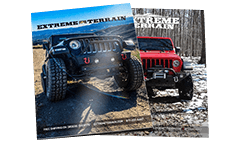

The Ultimate Jeep Suspension Guide
Jeeps are some of the most customizable vehicles around. The suspension, wheels, bumpers, lights, and engine are all easy to modify. Plus, Jeeps come with a suspension that handles most terrain well straight from the factory. However, changing your Jeep's suspension will help you unlock your Jeep's full potential.
All that said, picking the right suspension for your Jeep is tricky. It's important to consider the type of driving you do, if the Jeep is lifted, and where you live. The good news is that XT has all of the premium suspension kits you'll ever need for your Jeep.
What to Look for When Upgrading Your Suspension
A suspension system is a group of components that work together to absorb shock and provide stability. When upgrading your Jeep's suspension it's important to consider all of the necessary parts. While it's simple to upgrade just the springs, you're leaving performance on the table if you don't pair new springs with high-performance control arms.
Shocks and Springs
Shocks and springs are some of the most common suspension components to upgrade. Shocks absorb impact and upgrading them is important for off-roading applications. Springs help with handling and stiffer springs will improve handling.
Most Jeeps come with linear springs but it's a good idea to swap them out for progressive springs when off-roading. Linear springs provide constant tension, whereas progressive springs have different tension depending on the length of the spring. Dual-rate springs are also an option. These are springs with independent spring rates in a single coil, which gives you more flexibility.
Steering Stabilizer
The steering stabilizer is a small component that contributes to a Jeep's suspension system in a big way. Steering stabilizers prevent shock from impacting your steering. It's a good idea to upgrade the steering stabilizer along with shocks and struts for maximum performance.
Control Arms
Control arms do a few things for a Jeep's suspension. First, the control arms center the axle and wheels within the wheel arches. Second, control arms correct caster angles. A caster angle is the vertical axis that a steering wheel turns and most Jeeps benefit from a positive caster angle. Positive caster angles are in front of a tire's contact patch, which allows tires to straighten out naturally after steering.
Sway Bar
Sway bars connect parallel wheels. Every Jeep has a sway bar that connects the right wheels to the left wheels. The role of the sway bar is responsible for preventing major shifts in body weight that lift wheels off of the ground. When upgrading your suspension it comes down to sway bar links, which attach the sway bar to the wheels. If you plan on off-roading, you'll want to remove the factory links when you're on a trail. It's also possible to upgrade to off-road-focused sway bar links.
Bushings
Bushings are another small piece of the larger suspension system. The bushings on your Jeep's steering system impact how the vehicle handles. Stock bushings are usually rubber and lack durability. Replacing bushings on your Jeep with polyurethane bushings will help you improve your handling. Polyurethane bushings last longer and won't flex.
Off-Road vs City Life Suspension
When upgrading your Jeep's suspension your location is also a big factor. Driving a Jeep in the city is much different than climbing rocks, for example. Understanding the different needs of City suspensions and off-road suspensions will help you narrow down your options.
Off-Road Suspensions
Off-road suspensions will vary depending on the type of off-roading you're doing. In most cases, it's a good idea to lift your Jeep by about two to four inches. Lifting your Jeep in this way will give you more clearance when driving over rocks, hills, and other road hazards.
The next things to focus on are sway bars. Sway bars have connection links to the wheels that you'll want to remove when off-roading or climbing rocks. Other good off-road upgrades include bigger wheels and tires and polyurethane bushings.
City Life Suspension
Jeeps don't always have to be off-roading vehicles. While Jeeps come with a rugged suspension from the factory, it's easy to make them more commuter-friendly.
The biggest thing to avoid when upgrading your Jeep's suspension for city life is lifting it. While it's okay to lift it an inch or two, you'll increase your Jeep's center of gravity. Doing so decreases handling, increases the risk of tipping, and reduces gas mileage. However, an inch or two won't cause many problems.
The sway bar is also important for city life. Stiffer sway bars are better for commuting and city life. For city life, you also want stiffer shocks. Stiffer shocks will prevent you from feeling every pothole or bump in the road.
How to Maintain Your Suspension
Maintenance is key when it comes to your Jeep's suspension. Without the proper maintenance routine, the suspension won't last as long. Unfortunately, failing to maintain your suspension will also result in an increased risk of an accident occurring during off-roading.
Thankfully, XT has several tips to help you maintain your Jeep's suspension:
Make sure your wheel alignment is solid
Make sure you have the proper tire pressure (always check tire pressure before the winter)
Keep an eye on your tire treads
Inspect your bushings, joints, and steering stabilizer
Inspect the shocks and struts for damage
Check for a loss of compression in the springs
In the event of an accident or getting stuck when off-roading, inspect the entire suspension system
Have a technician look over your suspension every time you get an oil change or inspection
Following these maintenance tips will help you get the most use out of an upgraded Jeep suspension system.

